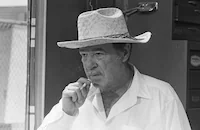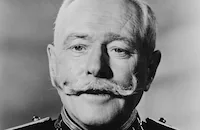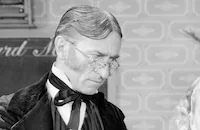The Nevadan
Brief Synopsis
Cast & Crew
Gordon Douglas
Randolph Scott
Dorothy Malone
Forrest Tucker
Frank Faylen
George Macready
Film Details
Technical Specs

Synopsis
After stealing a shipment of gold from a stagecoach, outlaw Tom Tanner is captured but escapes as he is being taken to jail. Tanner is followed by a man named Andy Barkley, whose style of dress suggests that he is a greenhorn. Tanner ambushes Barkley and forces him to trade clothes and accompany him to a bank, where Tanner removes an envelope from a safe deposit box containing a map to the stolen gold. On the road again, Tanner and Barkley are stopped by brothers Jeff and Bart, who demand the envelope at gunpoint. Unexpectedly, Barkley disarms the brothers and takes their horses. Barkley then explains that he is a fugitive just like Tanner and suggests that they join forces, but while Barkley sleeps, Tanner rides on without him. The following day, Barkley stops at a ranch run by Karen Galt and trades his lame horse for another, then heads for the nearby town of Twin Forks, which is run by Karen's father, Edward Galt. Barkley finds Tanner in the local saloon, but Tanner pretends not to know him. Their exchange piques Galt's interest, however, and he questions Barkley about Tanner's gold, which was not discovered after the robbery. When Barkley denies all knowledge of Tanner, Galt orders his henchmen, Jeff, Bart and Sandy, to beat him. That night, after Tanner kills an intruder in his room, Galt makes it look like cold-blooded murder to force him to reveal the gold's hiding place. Barkley later helps Tanner escape from jail in exchange for a share of the gold. The two men hide out on the old Galt ranch, which is now being used as a pasture for sick horses. When Karen discovers them there, Barkley is forced to disclose to her that he is a U.S. Marshal. Recognizing Tanner and Barkley's escape horses as belonging to his ranch, Galt later questions Karen about them, and she reveals Barkley's secret, not knowing that her father is after the gold himself. When Karen overhears Galt plotting with Jeff, Bart and Sandy, however, she realizes that Barkley's life is in danger and rides to the hideout to warn him. She is followed by one of Galt's men, who summons the others to the old ranch, and Karen meets them with gunfire, which gives Barkley and Tanner a head start. When Galt discovers Karen, he places her in Sandy's custody and, together with Jeff and Bart, tracks Barkley and Tanner. Galt and his men trail Tanner and Barkley to an old mine shaft where Tanner has hidden the stolen gold. During the ensuing gunfight, Galt and his men are killed. Barkley reveals that Tanner was allowed to escape so that the gold could be retrieved. When the mine shaft then caves in, Barkley overcomes Tanner. Barkley takes his prisoner back to jail, but Karen knows he will return because he has left his horse in her care.

Director

Gordon Douglas
Cast

Randolph Scott

Dorothy Malone

Forrest Tucker
Frank Faylen

George Macready

Charles Kemper

Jeff Corey

Tom Powers
Jock O'mahoney
Stanley Andrews

James Kirkwood
Kate Drain Lawson

Olin Howlin
Louis Mason
Nacho Galindo
Gertrude Chorre
Francis Mcdonald
Rosarita Varela
Budd Fine
Bill Wolfe

Charles Halton
Stanley Blystone
Art Loeb
Reed Howes
Jack Evans
Ethan Laidlaw
Tex Holden

Lillian Bronson
Jack Parker
Crew
George Brooks
Harry Joe Brown
Harry Joe Brown
Rowland Brown
Richard Fantl
George W. George
Frank Goodwin
Charles Lawton Jr.
Wilbur Mcgaugh
Arthur Morton
Randolph Scott
George F. Slavin
Morris Stoloff
Frank [a.] Tuttle

Film Details
Technical Specs

Articles
The Nevadan
Far from being just another by-the-numbers Western, The Nevadan brings enough twists and variations to a familiar genre that it received a favorable review from the New York Times. In a way such success shouldn't have been entirely unexpected since in addition to acting Randolph Scott also co-produced with Harry Joe Brown. This was one of fourteen films they did together, all intelligent and above-average Westerns starring Scott. (There were a further five films produced by Brown where Scott acted only.) One possible reason for their success with The Nevadan is that for the dialogue they brought in Rowland Brown, a sharp-edged writer who had directed the 30s cult favorites Blood Money (1933) and Hell's Highway (1932).
The Nevadan's outdoor scenes were filmed mostly in Lone Pine, California, a popular location that hosted a few hundred Westerns over the decades. But Lone Pine also proved useful for other types of films like Bad Day at Black Rock (1955), the 1936 Charge of the Light Brigade and the Brad Pitt/David Duchovny thriller Kalifornia (1993). Other parts of The Nevadan were shot on the Columbia Ranch in Burbank, which was established in 1934 and is apparently still being used today.
Much of The Nevadan's cast were Western veterans and their comfort with the genre meant that they were more convincing and inventive. The rancher is played by George Macready, familiar as a bad guy in dozens of films and easily distinguished by the facial scar he received in an auto accident. He later had a role on Peyton Place and co-owned an art gallery with fellow heavy Vincent Price.
The character of Sandy might seem familiar as well. That's Jock Mahoney, a prolific and wonderful stuntman who had doubled for Errol Flynn, Gregory Peck and even Randolph Scott (a job he also performed in The Nevadan). During the 40s he started acting as well and proved quite popular in dozens of Westerns but also a handful of Three Stooges films and Jolson Sings Again (1949). Mahoney starred in several TV Westerns and became Sally Field's stepfather (some people claim Field's' first screen appearance was in a Mahoney TV show).
Director: Gordon Douglas
Producer: Harry Joe Brown, Randolph Scott
Screenplay: Rowland Brown (dialogue), George W. George, George F. Slavin
Cinematography: Charles Lawton Jr.
Music: Arthur Morton
Art Direction: George Brooks
Cast: Randolph Scott (Andrew Barclay), Dorothy Malone (Karen Galt), Forrest Tucker (Tom Tanner), Frank Faylen (Jeff), George Macready (Edward Galt), Charles Kemper (Dyke Merrick), Jeff Corey (Bart).
C-81m.
by Lang Thompson

The Nevadan
Quotes
Trivia
Notes
The film's working title was Lawless. The stagecoach robbery takes place during the opening credits. Contemporary reviews state that the film was shot in color using the Cinecolor process, but the viewed print was in black and white and included no credit for color process. Some scenes were shot on location at Lone Pine and Hidden Valley, CA.

Miscellaneous Notes
Released in United States Winter February 1950
Released in United States Winter February 1950













